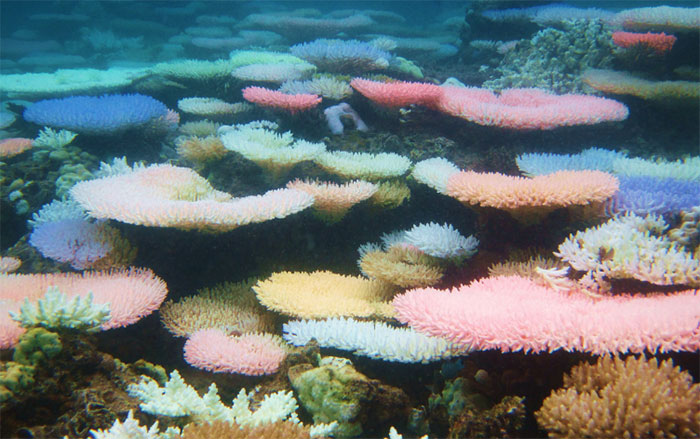Why do some reefs change colors when they are 'stressed'?
Instead of bleaching, some corals tend to change color as ocean temperatures fluctuate. This is a recent mystery that scientists have found out.
Usually the reason for coral bleaching is because healthy corals are stressed and expel algae that live inside their tissues.
Sometimes corals are bleached to light white, while there are other cases of corals with neon colors . Researchers believe this is due to a natural defense mechanism in the corals . Humans are thought to be the cause of warming ocean temperatures that are directly related to global warming.

Some corals have a way of protecting themselves by switching to colorful colors to help speed up their recovery.
Scientists have been studying the status of bleached corals for years, tracking the extent of damage to large and small reef systems and their recovery, they found that one thing strange. Sometimes a bleached reef system doesn't turn white as usual, it seems to be covered in other colors as well.
According to researchers Jörg Wiedenmann and Cecilia DêAngelo, it seems that some corals have a way of protecting themselves by switching to colorful colors to increase their speed of recovery when sea water returns to normal temperature.
The research begins by trying to determine why only some reefs become colorful during a bleaching stage while others become pale. Tests are conducted to see if this phenomenon can be replicated in a controlled environment. Until scientists looked at what was happening inside the stressed coral, they found the answer.
The researchers said healthy corals, most of the sunlight is absorbed by the photosynthesis process of algae. When corals lose their algae due to stress, the excess light travels back and forth inside the coral tissue, reflected by the white skeleton.
Algae inside the coral can recover after bleaching, once conditions return to normal. But when the inside of the coral is troubled, it can be very stressful for algae, potentially delaying or even preventing their return.
That's not good news because bleaching permanently leads to coral degradation and can destroy the coastal protection reefs of continents around the world. The estimated cost of damage to coastal areas if we let the reefs die would be greater than the amount we would have to spend to ensure their survival.
However, if corals are only slightly bleached, some color changes in an attempt to encourage algae to come back earlier. It seems to be something of a natural defense mechanism against ocean temperatures or poor water conditions, and scientists realize it happens more often than ever.
If the coral cells are still able to perform at least some of their normal functions during the bleaching process, then the increased level of internal light will promote the production of colorful coral protective pigments. from the destruction of light, forming a 'sunscreen' layer that allows algae to return. As the restored algae begin to absorb light for photosynthesis again, the level of light inside the reef decreases, so the coral stops producing many of these colorful pigments.
- The area of global coral is shrinking too fast
- Coral reefs are likely to disappear by 2050
- Surprise about the ability to distinguish colors of marine ornamental fish
- Break down the 'spooky tranquility', use sound to recover… the dead corals
- Nearly one third of Indonesia's coral reef area has been destroyed
- Why are people sick when stressed?
- Philippine paradise reef remains intact even though the world is in danger
- Heat-resistant coral reefs: struggle to survive when the Earth heats up
- Interactive fabric testing automatically changes colors
- Nearly 1 billion VND regenerates Khanh Hoa's coral reef
- Rescue coral reefs worldwide
- High water temperatures are one of the factors that damage coral reefs
 Surprised: Fish that live in the dark ocean still see colors
Surprised: Fish that live in the dark ocean still see colors Japan suddenly caught the creature that caused the earthquake in the legend
Japan suddenly caught the creature that caused the earthquake in the legend A series of gray whale carcasses washed ashore on California's coast
A series of gray whale carcasses washed ashore on California's coast Compare the size of shark species in the world
Compare the size of shark species in the world